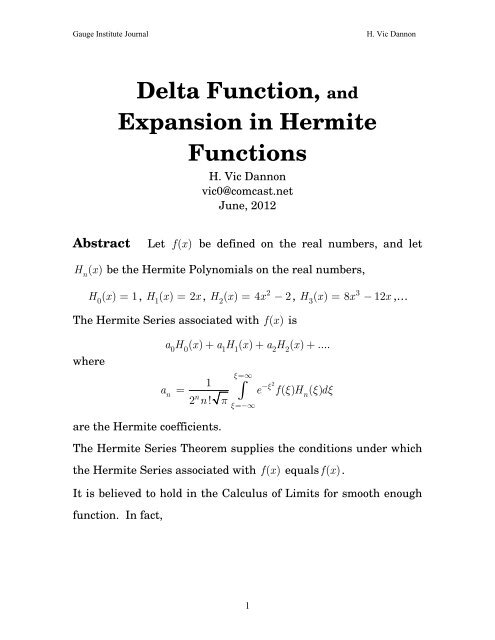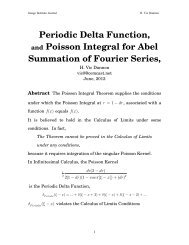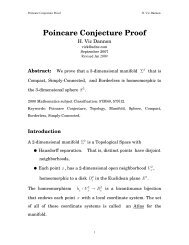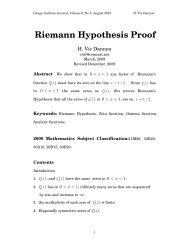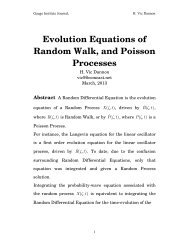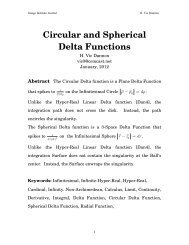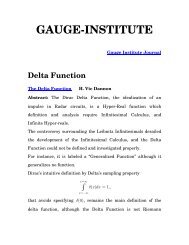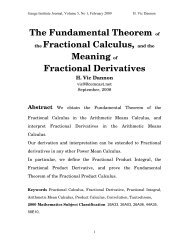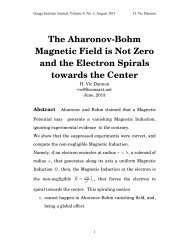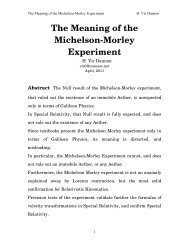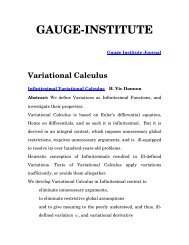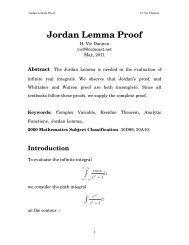Delta Function and Expansion in Hermite Functions
Delta Function and Expansion in Hermite Functions
Delta Function and Expansion in Hermite Functions
You also want an ePaper? Increase the reach of your titles
YUMPU automatically turns print PDFs into web optimized ePapers that Google loves.
Gauge Institute Journal<br />
H. Vic Dannon<br />
<strong>Delta</strong> <strong>Function</strong>, <strong>and</strong><br />
<strong>Expansion</strong> <strong>in</strong> <strong>Hermite</strong><br />
<strong>Function</strong>s<br />
H. Vic Dannon<br />
vic0@comcast.net<br />
June, 2012<br />
Abstract Let f ( x ) be def<strong>in</strong>ed on the real numbers, <strong>and</strong> let<br />
Hn ( x )<br />
be the <strong>Hermite</strong> Polynomials on the real numbers,<br />
H 0 ( x ) = 1,<br />
H 1 ( x) = 2x,<br />
H 2<br />
2 ( x) = 4x<br />
−2,<br />
H 3<br />
3 ( x) = 8x −12x<br />
,…<br />
The <strong>Hermite</strong> Series associated with f ( x ) is<br />
where<br />
aH( x) + aH( x) + aH( x) + ....<br />
0 0 1 1 2 2<br />
ξ=∞<br />
a 1<br />
2<br />
n<br />
() ()<br />
n<br />
n<br />
2 !<br />
e −ξ<br />
= ∫<br />
n<br />
f ξ H ξ dξ<br />
π<br />
ξ=−∞<br />
are the <strong>Hermite</strong> coefficients.<br />
The <strong>Hermite</strong> Series Theorem supplies the conditions under which<br />
the <strong>Hermite</strong> Series associated with f ( x ) equals f ( x ).<br />
It is believed to hold <strong>in</strong> the Calculus of Limits for smooth enough<br />
function. In fact,<br />
1
Gauge Institute Journal<br />
H. Vic Dannon<br />
The Theorem cannot be proved <strong>in</strong> the Calculus of Limits<br />
under any conditions,<br />
because the summation of the <strong>Hermite</strong> Series requires <strong>in</strong>tegration<br />
of the s<strong>in</strong>gular <strong>Hermite</strong> Kernel.<br />
Plots of partial sums of the <strong>Hermite</strong> Series speak volumes about<br />
the sensibility of the claims to have <strong>in</strong>f<strong>in</strong>ity bound by epsilon.<br />
In Inf<strong>in</strong>itesimal Calculus, the <strong>Hermite</strong> Kernel<br />
2<br />
{ ( ξ ) ( ) ... ( ) ( ) ...<br />
n n<br />
ξ<br />
n }<br />
1 ξ<br />
1<br />
π 0 0 2 n !<br />
e − H H x + + H H x +<br />
is the <strong>Delta</strong> <strong>Function</strong>, δξ− ( x)<br />
.<br />
δξ− ( x) equals its <strong>Hermite</strong> Series, <strong>and</strong> the <strong>Hermite</strong> Series<br />
associated with any hyper-real <strong>in</strong>tegrable f ( x ), equals f ( x )<br />
Keywords: Inf<strong>in</strong>itesimal, Inf<strong>in</strong>ite-Hyper-Real, Hyper-Real,<br />
<strong>in</strong>f<strong>in</strong>ite Hyper-real, Inf<strong>in</strong>itesimal Calculus, <strong>Delta</strong> <strong>Function</strong>,<br />
<strong>Hermite</strong> Polynomials, <strong>Hermite</strong> Coefficients, <strong>Delta</strong> <strong>Function</strong>,<br />
<strong>Hermite</strong> Series, <strong>Hermite</strong> Kernel, <strong>Expansion</strong> <strong>in</strong> <strong>Hermite</strong> <strong>Function</strong>s,<br />
2000 Mathematics Subject Classification 26E35; 26E30;<br />
26E15; 26E20; 26A06; 26A12; 03E10; 03E55; 03E17; 03H15;<br />
46S20; 97I40; 97I30.<br />
2
Gauge Institute Journal<br />
H. Vic Dannon<br />
Contents<br />
0. The Orig<strong>in</strong> of the <strong>Hermite</strong> Series Theorem<br />
1. Divergence of the Hermit Kernel <strong>in</strong> the Calculus of Limits<br />
2. Hyper-real l<strong>in</strong>e.<br />
3. Integral of a Hyper-real <strong>Function</strong><br />
4. <strong>Delta</strong> <strong>Function</strong><br />
5. Convergent Series<br />
6. <strong>Hermite</strong> Sequence <strong>and</strong> δξ− ( x)<br />
7. <strong>Hermite</strong> Kernel <strong>and</strong> δξ− ( x)<br />
.<br />
8. <strong>Hermite</strong> Series of δξ− ( x)<br />
9. <strong>Hermite</strong> Series Theorem<br />
References<br />
3
Gauge Institute Journal<br />
H. Vic Dannon<br />
The Orig<strong>in</strong> of the <strong>Hermite</strong> Series<br />
Theorem<br />
The <strong>Hermite</strong> Polynomials on ( −∞,<br />
∞)<br />
H 0 ( x ) = 1,<br />
H 1 ( x) = 2x,<br />
H 2<br />
2 ( x) = 4x<br />
−2,<br />
H 3<br />
3 ( x) = 8x −12x<br />
,…,<br />
are orthogonal so that<br />
x =∞<br />
2<br />
−x<br />
n<br />
∫ e Hm( x) Hn( x) dx = 2 n!<br />
πδm<br />
n .<br />
x =−∞<br />
The <strong>Hermite</strong> Polynomials can be generated by exp<strong>and</strong><strong>in</strong>g<br />
2<br />
2xα−α<br />
2 1 2 2 1<br />
2! 3!<br />
e = 1 + [2 xα− α ] + [2 xα− α ] + [2 xα− α ] + ...<br />
2 1 2 2 3 4<br />
2!<br />
= 1+ 2 xα− α + [4x α − 4 xα + α ] +<br />
1 0<br />
the coefficient of α is 0! H 0 ( x ) = 1,<br />
1 1<br />
the coefficient of α is 1! H 1 ( x) = 2x,<br />
1 2<br />
the coefficient of α is 2! H 2<br />
2 ( x) = 4x<br />
− 2,<br />
3<br />
the coefficient of<br />
1<br />
α is 3! H 3<br />
3 ( x) = 8x − 12x<br />
,<br />
1<br />
3!<br />
2 3<br />
3 3 2 4 5 6<br />
+ [8 x α − 12 x α + 6 xα<br />
− α ] + ...<br />
…………………………<br />
4
Gauge Institute Journal<br />
H. Vic Dannon<br />
0.1 Schrod<strong>in</strong>ger Equation for atomic size particle <strong>in</strong><br />
l<strong>in</strong>ear harmonic motion<br />
An atomic size particle with mass m , oscillates along a segment<br />
of wire [ − AA , ], at frequency ν , under the force −kx .<br />
The particle’s position is<br />
Thus,<br />
xt () = Acosωt, ω = 2πν.<br />
x<br />
=−ωAs<strong>in</strong><br />
ωt<br />
The force equation is<br />
x<br />
=− ω Acos<br />
ωt<br />
=−ω<br />
2 2<br />
− kx = mx = m( −ω x)<br />
.<br />
2<br />
x<br />
Hence, the force constant is<br />
k = mω 2 ,<br />
<strong>and</strong> the potential energy of the particle is<br />
1 2 1 2<br />
2 2<br />
2<br />
V = kx = mω x .<br />
De Broglie associated with the mov<strong>in</strong>g particle a wave of length<br />
h<br />
λ = ,<br />
mv<br />
where v is the velocity of the particle, <strong>and</strong> h is Planck’s constant.<br />
The wave’s frequency is<br />
ν<br />
= v v mv<br />
λ<br />
= = h<br />
.<br />
h<br />
mv<br />
2<br />
The wave’s angular frequency is<br />
5
Gauge Institute Journal<br />
H. Vic Dannon<br />
ω = 2πν = 2π<br />
mv h<br />
2<br />
In terms of the De Broglie wave, the particle’s energy is a multiple<br />
of Planck’s radiation energy,<br />
E<br />
= εν h = εω ,<br />
= , ε is the multiplier.<br />
h<br />
2π<br />
The k<strong>in</strong>etic energy of the particle is<br />
Hence,<br />
2<br />
1<br />
mv = E − V .<br />
2<br />
mv = 2 m( E − V ),<br />
λ =<br />
h<br />
2 mE ( − V)<br />
,<br />
v<br />
= λν<br />
=<br />
1<br />
ω 2π ω<br />
.<br />
2 mE ( −V)<br />
1 2 mE ( −V)<br />
=<br />
2 2 2<br />
v ω<br />
Schrod<strong>in</strong>ger postulated a complex valued potential<br />
Ψ (,) xt = ψ() xe iωt<br />
that satisfies the wave equation<br />
Then,<br />
2 1 2<br />
∂Ψ<br />
x<br />
(,) xt = ∂Ψ (,)<br />
2 t<br />
xt .<br />
v<br />
2 1 2<br />
0 =∂xΨ( xt , ) − ∂Ψ (<br />
2 t<br />
xt , )<br />
v<br />
6
Gauge Institute Journal<br />
H. Vic Dannon<br />
iωt<br />
2 mE ( −V)<br />
2 iωt<br />
= ψ"( xe ) − ψ( x)( −ω ) e .<br />
2 2<br />
ω<br />
The Schrod<strong>in</strong>ger equation for the l<strong>in</strong>ear harmonic oscillator is<br />
2m<br />
ψ"( x) + ( E − V) ψ( x) = 0 .<br />
2<br />
<br />
Substitut<strong>in</strong>g E , <strong>and</strong> V ,<br />
2m<br />
1 2 2<br />
ψ" + ( εω − mω x ) ψ<br />
2<br />
2<br />
<br />
=<br />
0<br />
Multiply<strong>in</strong>g by mω<br />
,<br />
2<br />
<br />
mω<br />
2<br />
ψ"( x) + (2 ε− x ) ψ( x) = 0 .<br />
mω<br />
<br />
ξ<br />
The change of variable<br />
ξ = mω<br />
<br />
x , gives<br />
dψ dψdξ<br />
= =<br />
dx dξ<br />
dx<br />
ψ'( ξ) m<br />
ω<br />
, <br />
<strong>and</strong> the equation becomes<br />
2<br />
mω<br />
{ }<br />
d ψ d dξ<br />
= ψ'( ξ) = ψ''( ξ)<br />
2<br />
dx dξ<br />
dx<br />
mω<br />
,<br />
<br />
ψ"( ξ) + (2 ε− ξ ) ψ( x) = 0 .<br />
2<br />
0.2 <strong>Hermite</strong> Differential Equation<br />
The Schrod<strong>in</strong>ger equation<br />
7
Gauge Institute Journal<br />
H. Vic Dannon<br />
can be factored<br />
2<br />
ψ"( ξ) − ξ ψ( x) = − 2 εψ( x)<br />
( D − ξ)( D + ξ) ψ( x) = − 2εψ( x)<br />
.<br />
ξ<br />
ξ<br />
To solve the homogeneous equation<br />
( D − ξ)( D + ξ) ψ( x)<br />
= 0,<br />
ξ<br />
we solve<br />
ψ '<br />
( Dξ<br />
− ξψ ) ( x) = 0 ⇒ ξ<br />
ψ = ⇒ 1 2<br />
log ψ = ξ + c ⇒<br />
2<br />
As ξ →∞, ψ 1<br />
→∞, <strong>and</strong> is discarded.<br />
ξ<br />
ψ<br />
2<br />
1<br />
= Ce ξ<br />
.<br />
1<br />
2<br />
( D + ξψ ) ( x) = 0 ⇒<br />
ξ<br />
Now, substitut<strong>in</strong>g<br />
ψ '<br />
ξ<br />
ψ =− ⇒ 1 2<br />
log ψ =− ξ + c ⇒<br />
2<br />
ψξ () = H()<br />
ξe<br />
−<br />
1<br />
2<br />
ξ<br />
2<br />
−<br />
1<br />
2<br />
ξ<br />
ψ2 = Ce .<br />
2<br />
<strong>in</strong><br />
2<br />
ψ"( ξ) + (2 ε− ξ ) ψ( ξ) = 0 , we have<br />
− ξ<br />
( )<br />
1 2 1 2<br />
− ξ<br />
2 2<br />
2 2<br />
0 = Dξ H( ξ) e + (2 ε−<br />
ξ ) H( ξ)<br />
e<br />
2 2<br />
−1 1<br />
( ξ<br />
− ξ<br />
)<br />
= Dξ H '( ξ) e − ξH( ξ) e + (2 ε−ξ ) H( ξ)<br />
e<br />
2 2 2<br />
1 ξ 2 1 ξ 2 1<br />
ξ 2<br />
2 2 2 2<br />
− − −<br />
1<br />
− 2 ξ<br />
= H ''() ξ e −2 ξH '() ξ e − H() ξ e + ξ H()<br />
ξ e<br />
−<br />
= ⎡H ''( ξ) 2 ξH '( ξ) (2ε 1) H( ξ)<br />
⎤<br />
⎣<br />
− + −<br />
⎦<br />
e ξ<br />
1<br />
2<br />
2<br />
.<br />
2<br />
1<br />
ξ 2<br />
2<br />
− +<br />
+ (2 − ) ( )<br />
1<br />
2<br />
2<br />
ξ<br />
ε ξ H ξ e<br />
−<br />
The Schrod<strong>in</strong>ger equation becomes Hermit Differential Equation<br />
H ''( ξ) − 2 ξH '( ξ) + (2ε− 1) H( ξ) = 0,<br />
2<br />
8
Gauge Institute Journal<br />
H. Vic Dannon<br />
Substitut<strong>in</strong>g <strong>in</strong> it<br />
we have<br />
2 l l+ 1 l+<br />
2<br />
0 1 2 l l+ 1 l+<br />
2<br />
H ( ξ ) = c + c ξ + c ξ + ... + c ξ + c ξ + c ξ + ... ,<br />
l=∞ l=∞ l=∞<br />
2 l<br />
l<br />
ξ∑ l<br />
− 2<br />
ξ∑ l<br />
+ (2 −1)<br />
∑ l<br />
l= 0 l= 0 l=<br />
0<br />
D cξ ξD cξ ε cξ<br />
<br />
l=∞ l=∞<br />
l−2 l−1<br />
∑ ( l−1)<br />
lclξ<br />
∑ lclξ<br />
l= 2 l=<br />
1<br />
l<br />
=<br />
0,<br />
l =∞<br />
l<br />
∑ {( l + 1)( l + 2) cl+<br />
2<br />
− 2 lcl + (2ε− 1) cl} ξ = 0 ,<br />
l = 0<br />
( l + 1)( l + 2) c − [2 l + 1− 2 ε]<br />
c =<br />
l+<br />
2<br />
l<br />
0<br />
c<br />
l+<br />
2<br />
= 2l<br />
+ 1−2ε<br />
c<br />
( l + 1)( l + 2)<br />
l<br />
The solution is<br />
1−2 2 3 2 3<br />
0 1 0 ε<br />
− ε<br />
12 1<br />
ξ<br />
⋅<br />
23 ⋅<br />
H()<br />
ξ = c + c ξ + c ξ + c +<br />
1−2<br />
2 (1 2 )(5 2 ) 4<br />
0 ε − ε − ε<br />
ξ<br />
ξ<br />
12 ⋅<br />
1234 ⋅ ⋅ ⋅<br />
= c {1 + + + ...} +<br />
(1−2 ε)(5−2 ε) 4 (3−2 ε)(7−2 ε)<br />
5<br />
0<br />
ξ c<br />
1234 1<br />
ξ<br />
⋅⋅⋅<br />
2345 ⋅⋅⋅<br />
+ c<br />
+ + ...<br />
3−2ε<br />
2 (3−2 ε)(7−2 ε)<br />
4<br />
1ξ ξ ξ<br />
23 ⋅<br />
2345 ⋅ ⋅ ⋅<br />
To keep the solution from diverg<strong>in</strong>g at ξ →∞,<br />
for n = 2k, the c0<br />
series terms vanish for<br />
+ c {1 + + + ...} .<br />
2ε = 1,5, 9,13,...4k<br />
+ 1,... ,<br />
<strong>and</strong> we obta<strong>in</strong> the<br />
H2 k<br />
() ξ<br />
<strong>Hermite</strong> Polynomials.<br />
9
Gauge Institute Journal<br />
H. Vic Dannon<br />
for n = 2k<br />
+1, the c1<br />
series terms vanish for<br />
2ε = 3,7,11,..., 4k<br />
+ 3,...<br />
<strong>and</strong> we obta<strong>in</strong> the<br />
H<br />
2k<br />
+ 1 () ξ<br />
<strong>Hermite</strong> Polynomials.<br />
A solution for<br />
ψξ ()<br />
is the <strong>in</strong>f<strong>in</strong>ite l<strong>in</strong>ear comb<strong>in</strong>ation<br />
1 2 1 2<br />
1 2<br />
2 2 2 +<br />
− ξ − ξ − ξ<br />
0H0 e +<br />
1H1 e +<br />
2H2<br />
e<br />
α () ξ α () ξ α () ξ ....<br />
0.3 The <strong>Hermite</strong> Series Associated with f ( x )<br />
Let f ( x ) be def<strong>in</strong>ed on ( −∞, ∞ ) , <strong>and</strong> let H ( x)<br />
be the <strong>Hermite</strong><br />
Polynomials<br />
H 0 ( x ) = 1,<br />
H 1 ( x) = 2x,<br />
H 2<br />
2 ( x) = 4x<br />
−2,<br />
H 3<br />
3 ( x) = 8x −12x<br />
,…<br />
The Polynomials are orthogonal on ( −∞,<br />
∞)<br />
. That is,<br />
x =∞<br />
∫<br />
x =−∞<br />
−x<br />
2<br />
n<br />
m n mn<br />
e H ( x) H ( x) dx = 2 n!<br />
πδ<br />
We def<strong>in</strong>e the Orthonormalized <strong>Hermite</strong> <strong>Function</strong>s<br />
1<br />
1 2<br />
− x<br />
ϕ ( )<br />
2<br />
n<br />
x = e H ( )<br />
1 n<br />
x<br />
n<br />
(2 n ! π)<br />
2<br />
If f ( x ) can be exp<strong>and</strong>ed <strong>in</strong> the ϕ n( x ),<br />
Then,<br />
f ( x) = αϕ( x) + αϕ( x) + αϕ( x) + ...,<br />
0 0 1 1 2 2<br />
n<br />
10
Gauge Institute Journal<br />
H. Vic Dannon<br />
x=∞ x=∞<br />
∫ ϕn<br />
= ∫ α0ϕ0 + αϕ<br />
1 1<br />
+ α2ϕ2<br />
+ ϕn<br />
x=−∞<br />
x=−∞<br />
f ( x ) ( x ) dx { ( x ) ( x ) ( x ) ...} ( x ) dx<br />
x=∞ x=∞ x=∞<br />
∫ ∫ ∫<br />
= α ϕ ( x ) ϕ ( x ) dx + α ϕ ( x ) ϕ ( x ) dx + α ϕ ( x ) ϕ ( x ) dx ..<br />
= α n<br />
.<br />
0 0 n<br />
1 1 n<br />
2 2<br />
x=−∞ x=−∞ x=−∞<br />
δ δ δ<br />
0n 1n 2n<br />
n<br />
+<br />
<br />
Thus, the <strong>Hermite</strong> coefficients with respect to the<br />
ϕ n( x )<br />
are<br />
α<br />
n<br />
ξ=∞<br />
= ∫ f () ξ ϕ () ξ dξ.<br />
ξ=−∞<br />
n<br />
The Orthonormal <strong>Hermite</strong> Series associated with f ( x ) is<br />
αϕ( x) + αϕ( x) + αϕ( x) + ....<br />
0 0 1 1 2 2<br />
11
Gauge Institute Journal<br />
H. Vic Dannon<br />
1.<br />
Divergence of the Hermit Kernel<br />
<strong>in</strong> the Calculus of Limits<br />
Calculus of Limits Conditions for the <strong>Hermite</strong> Series to equal its<br />
function reflect the belief that a smooth enough function equals its<br />
<strong>Hermite</strong> Series.<br />
In fact, <strong>in</strong> the Calculus of Limits, no smoothness of the function<br />
guarantees even the convergence of the <strong>Hermite</strong> Series.<br />
1.1 The <strong>Hermite</strong> Kernel is either s<strong>in</strong>gular or zero<br />
In the Calculus of Limits, the <strong>Hermite</strong> Series is the limit of the<br />
sequence of Partial Sums<br />
{ f x } αϕ<br />
0 0<br />
H S ( ) = ( x) + ... + αϕ( x )<br />
ermite n n n<br />
As n<br />
⎛ ξ=∞ ⎞ ξ=∞<br />
() 0 () ⎛<br />
⎞<br />
f d<br />
0<br />
() x .. ξϕ ξ ξ ϕ f () ξϕn<br />
() = ξdξ + +<br />
ϕ<br />
∫ ∫ n<br />
⎜<br />
()<br />
⎝ξ=−∞<br />
⎠⎟<br />
⎝⎜ξ=−∞<br />
⎟<br />
x<br />
⎠<br />
ξ=∞<br />
∫ f () ξ { ϕ0 () ξ ϕ0<br />
() x ... ϕn<br />
() ξ ϕn<br />
() x } d ξ.<br />
ξ=−∞<br />
= + +<br />
→∞, the orthonormal <strong>Hermite</strong> Sequence<br />
ϕ () ξ ϕ () x + ... + ϕ () ξ ϕ () x<br />
0 0<br />
n<br />
n<br />
12
Gauge Institute Journal<br />
H. Vic Dannon<br />
becomes the orthonormal <strong>Hermite</strong> Kernel,<br />
ϕ ( ξ ) ϕ ( x ) + ... + ϕ ( ξ ) ϕ ( x ) + ... ,<br />
0 0<br />
n<br />
n<br />
To see that it is s<strong>in</strong>gular at<br />
ξ = x , we apply the Christoffel<br />
Summation Formula, [Sansone, p.371],<br />
ϕ () ξ ϕ () x + ... + ϕ () ξ ϕ () x =<br />
0 0<br />
n<br />
n<br />
n + 1 ϕn+ 1() ξ ϕn() x − ϕn() ξ ϕn+<br />
1()<br />
x<br />
.<br />
2<br />
ξ − x<br />
For ξ → x ,<br />
2 2<br />
0 0<br />
x<br />
n n<br />
x<br />
0<br />
x<br />
n<br />
ϕ ( ξ) ϕ ( ) + ... + ϕ ( ξ) ϕ ( ) → ϕ ( ) + ... + ϕ ( x ),<br />
<strong>and</strong><br />
n<br />
+ 1ϕn+ 1() ξ ϕn() x − ϕn() ξ ϕn+<br />
1()<br />
x n + 10<br />
→<br />
2 ξ − x<br />
2 0 .<br />
Apply<strong>in</strong>g Bernoulli’s rule to the <strong>in</strong>determ<strong>in</strong>ate limit,<br />
ϕn+ 1() ξ ϕn() x − ϕn() ξ ϕn+<br />
1()<br />
x<br />
lim<br />
ξ→x<br />
ξ −x<br />
=<br />
Dξϕn+ 1() ξ ϕn() x − Dξϕn() ξ ϕn+<br />
1()<br />
x<br />
lim<br />
ξ→x<br />
D ( ξ −x)<br />
ξ<br />
= lim[ ϕ '( ξ) ϕ ( x) −ϕ '( ξ) ϕ ( x)]<br />
ξ→x<br />
n+ 1 n n n+<br />
1<br />
= ϕ '( x ) ϕ ( x ) −ϕ '( x ) ϕ ( x )<br />
n+ 1 n n n+<br />
1<br />
Therefore,<br />
2 2 n + 1<br />
ϕ0( x) + ... + ϕn( x) = [ ϕn+ 1'( x) ϕn( x) −ϕn<br />
'( x) ϕn+<br />
1( x )].<br />
2<br />
S<strong>in</strong>ce ϕ n( x ), <strong>and</strong> ϕ n 1 ( x ) solve the differential equation, [Szego,<br />
+<br />
13<br />
p.105, #5.5.2],
Gauge Institute Journal<br />
H. Vic Dannon<br />
we have,<br />
1 ⋅ z''( x) + 0 ⋅ z'( x) + (2n + 1 − x ) z( x) = 0,<br />
ax ( ) bx ( )<br />
ϕ '( x) ϕ ( x) − ϕ '( x) ϕ ( x) = ( const)<br />
e<br />
n+ 1 n n n+<br />
1<br />
2<br />
−<br />
∫<br />
bx ( )<br />
dx a( x)<br />
=<br />
( const)<br />
e∫<br />
0⋅dx<br />
= const ,<br />
for any −∞ < x < ∞.<br />
Hence,<br />
2 2 n + 1<br />
ϕ0( x) + ... + ϕn<br />
( x)<br />
= const<br />
2<br />
<strong>and</strong> the <strong>Hermite</strong> Kernel diverges to ∞ at any ξ = x .<br />
Therefore, while the partial sums of the <strong>Hermite</strong> Series exist,<br />
their limit does not. That is, due to the s<strong>in</strong>gularity at<br />
ξ = x , the<br />
<strong>Hermite</strong> Series does not converge <strong>in</strong> the Calculus of Limits.<br />
Avoid<strong>in</strong>g the s<strong>in</strong>gularity at<br />
ξ = x , by us<strong>in</strong>g the Cauchy Pr<strong>in</strong>cipal<br />
Value of the <strong>in</strong>tegral does not recover the Theorem, because at any<br />
ξ ≠ x , the <strong>Hermite</strong> Kernel vanishes, <strong>and</strong> the <strong>in</strong>tegral will be<br />
identically zero, for any function<br />
f ( x ).<br />
To see that the kernel vanishes for any<br />
ξ ≠ x , we apply the<br />
Christoffel Summation Formula, with ξ ≠ x .<br />
n+ 1<br />
ϕn+ 1<br />
ξ ϕn x − ϕn ξ ϕn+<br />
1<br />
0() 0() x + ... +<br />
n() n()<br />
x =<br />
2<br />
ϕ ξ ϕ ϕ ξ ϕ<br />
() () () () x<br />
.<br />
ξ − x<br />
14
Gauge Institute Journal<br />
H. Vic Dannon<br />
We have<br />
1<br />
1 2<br />
− x<br />
ϕ ( )<br />
2<br />
n<br />
x = e H ( )<br />
1 n<br />
x<br />
n<br />
(2 n ! π)<br />
2<br />
=<br />
n<br />
1<br />
1<br />
2<br />
(2 n ! π)<br />
1 2<br />
x 2<br />
2 −x<br />
e e H ( x)<br />
n<br />
By [Szego, p. 105, #5.5.3],<br />
Thus,<br />
<strong>and</strong><br />
ϕ<br />
−x<br />
2 2<br />
e H ( x ) ( 1) D n<br />
= − e x .<br />
n<br />
n<br />
( −1)<br />
1 2<br />
x 2<br />
( )<br />
2 n −x<br />
ϕn<br />
x = e D { }<br />
1 x<br />
e ,<br />
n<br />
(2 n ! π)<br />
2<br />
n+<br />
1<br />
n<br />
n+<br />
1<br />
( −1)<br />
1 2<br />
x 2<br />
2 n+ 1 −x<br />
( x) =<br />
e D { }<br />
1 x<br />
e<br />
n+<br />
1<br />
(2 ( n + 1)! π)<br />
2<br />
x<br />
−<br />
n+ 1<br />
ϕn+<br />
1<br />
ξ ϕn x − ϕn ξ ϕn+1<br />
x<br />
2<br />
() () () ()<br />
ξ − x<br />
=<br />
→0,<br />
n→∞<br />
2n<br />
+ 1<br />
n+ 1 −ξ<br />
{ 2 n −x 2 n − ξ<br />
2 n+ 1 −x Dξ<br />
{ e } Dx{ e } Dξ{ e } Dx<br />
{ e<br />
2<br />
}}<br />
1 n+<br />
1 ( −1)<br />
= −<br />
ξ − x<br />
2 n<br />
2 2 πn!( n + 1)! <br />
<br />
→0,<br />
n→∞<br />
→<br />
0, as n<br />
→ ∞.<br />
That is, the <strong>Hermite</strong> Kernel vanishes for any ξ ≠ x .<br />
Plots of the <strong>Hermite</strong> Sequence confirm that<br />
In the Calculus of Limits,<br />
the <strong>Hermite</strong> Kernel is either s<strong>in</strong>gular or zero<br />
15
Gauge Institute Journal<br />
H. Vic Dannon<br />
1.2 Plots of<br />
2<br />
1 − ξ<br />
1<br />
0<br />
ξ<br />
0<br />
+ +<br />
n<br />
π<br />
2 n ! n<br />
ξ<br />
n<br />
e { H ( ) H ( x ) ... H ( ) H ( x )}<br />
In Maple,<br />
223<br />
∑<br />
i = 0<br />
2<br />
1 −x<br />
1<br />
π<br />
i<br />
2 i !<br />
plot( e * <strong>Hermite</strong>H(,.5)* i <strong>Hermite</strong>H(, i x), x =− 23..23)<br />
In Maple,<br />
223<br />
2<br />
1 −x<br />
1<br />
∑ − = − 3..23)<br />
i<br />
plot( e * <strong>Hermite</strong>H( i, 1)* <strong>Hermite</strong>H( i, x), x 2<br />
i = 0<br />
π<br />
2 i !<br />
16
Gauge Institute Journal<br />
H. Vic Dannon<br />
x 2<br />
e − that suppresses oscillations away from the orig<strong>in</strong>, enhances<br />
them at the orig<strong>in</strong>. Thus, a s<strong>in</strong>gularity away from the orig<strong>in</strong><br />
needs more terms<br />
In Maple,<br />
223<br />
2<br />
1 −x<br />
1<br />
∑<br />
i<br />
π 2 i !<br />
i = 0<br />
plot( e * <strong>Hermite</strong>H( i, 2) * <strong>Hermite</strong>H( i, x), x =− 23..23)<br />
The plots confirm that the <strong>Hermite</strong> Series Theorem cannot be<br />
proved <strong>in</strong> the Calculus of Limits.<br />
1.3 Inf<strong>in</strong>itesimal Calculus Solution<br />
By resolv<strong>in</strong>g the problem of the <strong>in</strong>f<strong>in</strong>itesimals [Dan2], we obta<strong>in</strong>ed<br />
the Inf<strong>in</strong>ite Hyper-reals that are strictly smaller than ∞ , <strong>and</strong><br />
constitute the value of the <strong>Delta</strong> <strong>Function</strong> at the s<strong>in</strong>gularity.<br />
The controversy surround<strong>in</strong>g the Leibnitz Inf<strong>in</strong>itesimals derailed<br />
the development of the Inf<strong>in</strong>itesimal Calculus, <strong>and</strong> the <strong>Delta</strong><br />
17
Gauge Institute Journal<br />
H. Vic Dannon<br />
<strong>Function</strong> could not be def<strong>in</strong>ed <strong>and</strong> <strong>in</strong>vestigated properly.<br />
In Inf<strong>in</strong>itesimal Calculus, [Dan3], we can differentiate over jump<br />
discont<strong>in</strong>uities, <strong>and</strong> <strong>in</strong>tegrate over s<strong>in</strong>gularities.<br />
The <strong>Delta</strong> <strong>Function</strong>, the idealization of an impulse <strong>in</strong> Radar<br />
circuits, is a Discont<strong>in</strong>uous Hyper-Real function which def<strong>in</strong>ition<br />
requires Inf<strong>in</strong>ite Hyper-reals, <strong>and</strong> which analysis requires<br />
Inf<strong>in</strong>itesimal Calculus.<br />
In [Dan5], we show that <strong>in</strong> <strong>in</strong>f<strong>in</strong>itesimal Calculus, the hyper-real<br />
ω=∞<br />
1<br />
( x)<br />
e i ω<br />
δ = x ω<br />
2π<br />
∫ d<br />
ω=−∞<br />
is zero for any x ≠ 0 ,<br />
it spikes at<br />
x = 0 , so that its Inf<strong>in</strong>itesimal Calculus<br />
x =∞<br />
∫<br />
<strong>in</strong>tegral is δ( xdx ) = 1,<br />
<strong>and</strong><br />
x =−∞<br />
1<br />
δ (0) = < ∞.<br />
dx<br />
Here, we show that <strong>in</strong> Inf<strong>in</strong>itesimal calculus, the <strong>Hermite</strong> Kernel<br />
is a hyper-real <strong>Delta</strong> <strong>Function</strong>.<br />
egendre<br />
And the <strong>Hermite</strong> Series L S { f ( x)<br />
associated with a Hyperreal<br />
function f ( x ), equals f ( x ).<br />
}<br />
18
Gauge Institute Journal<br />
H. Vic Dannon<br />
2.<br />
Hyper-real L<strong>in</strong>e<br />
Each real number α can be represented by a Cauchy sequence of<br />
rational numbers, ( r , r , r ,...) so that r → α .<br />
1 2 3<br />
The constant sequence ( ααα , , ,...) is a constant hyper-real.<br />
In [Dan2] we established that,<br />
1. Any totally ordered set of positive, monotonically decreas<strong>in</strong>g<br />
n<br />
to zero sequences<br />
<strong>in</strong>f<strong>in</strong>itesimal hyper-reals.<br />
( ι1, ι2, ι3,...)<br />
constitutes a family of<br />
2. The <strong>in</strong>f<strong>in</strong>itesimals are smaller than any real number, yet<br />
strictly greater than zero.<br />
1 1 1<br />
3. Their reciprocals ( , , ,...<br />
ι 1<br />
ι 2<br />
ι 3<br />
) are the <strong>in</strong>f<strong>in</strong>ite hyper-reals.<br />
4. The <strong>in</strong>f<strong>in</strong>ite hyper-reals are greater than any real number,<br />
yet strictly smaller than <strong>in</strong>f<strong>in</strong>ity.<br />
5. The <strong>in</strong>f<strong>in</strong>ite hyper-reals with negative signs are smaller<br />
than any real number, yet strictly greater than −∞.<br />
6. The sum of a real number with an <strong>in</strong>f<strong>in</strong>itesimal is a<br />
non-constant hyper-real.<br />
7. The Hyper-reals are the totality of constant hyper-reals, a<br />
family of <strong>in</strong>f<strong>in</strong>itesimals, a family of <strong>in</strong>f<strong>in</strong>itesimals with<br />
19
Gauge Institute Journal<br />
H. Vic Dannon<br />
negative sign, a family of <strong>in</strong>f<strong>in</strong>ite hyper-reals, a family of<br />
<strong>in</strong>f<strong>in</strong>ite hyper-reals with negative sign, <strong>and</strong> non-constant<br />
hyper-reals.<br />
8. The hyper-reals are totally ordered, <strong>and</strong> aligned along a<br />
l<strong>in</strong>e: the Hyper-real L<strong>in</strong>e.<br />
9. That l<strong>in</strong>e <strong>in</strong>cludes the real numbers separated by the nonconstant<br />
hyper-reals. Each real number is the center of an<br />
<strong>in</strong>terval of hyper-reals, that <strong>in</strong>cludes no other real number.<br />
10. In particular, zero is separated from any positive real<br />
by the <strong>in</strong>f<strong>in</strong>itesimals, <strong>and</strong> from any negative real by the<br />
<strong>in</strong>f<strong>in</strong>itesimals with negative signs, −dx .<br />
11. Zero is not an <strong>in</strong>f<strong>in</strong>itesimal, because zero is not strictly<br />
greater than zero.<br />
12. We do not add <strong>in</strong>f<strong>in</strong>ity to the hyper-real l<strong>in</strong>e.<br />
13. The <strong>in</strong>f<strong>in</strong>itesimals, the <strong>in</strong>f<strong>in</strong>itesimals with negative<br />
signs, the <strong>in</strong>f<strong>in</strong>ite hyper-reals, <strong>and</strong> the <strong>in</strong>f<strong>in</strong>ite hyper-reals<br />
with negative signs are semi-groups with<br />
respect to addition. Neither set <strong>in</strong>cludes zero.<br />
14. The hyper-real l<strong>in</strong>e is embedded <strong>in</strong> , <strong>and</strong> is not<br />
∞<br />
homeomorphic to the real l<strong>in</strong>e. There is no bi-cont<strong>in</strong>uous<br />
one-one mapp<strong>in</strong>g from the hyper-real onto the real l<strong>in</strong>e.<br />
20
Gauge Institute Journal<br />
H. Vic Dannon<br />
15. In particular, there are no po<strong>in</strong>ts on the real l<strong>in</strong>e that<br />
can be assigned uniquely to the <strong>in</strong>f<strong>in</strong>itesimal hyper-reals, or<br />
to the <strong>in</strong>f<strong>in</strong>ite hyper-reals, or to the non-constant hyperreals.<br />
16. No neighbourhood of a hyper-real is homeomorphic to<br />
an<br />
n<br />
ball. Therefore, the hyper-real l<strong>in</strong>e is not a manifold.<br />
17. The hyper-real l<strong>in</strong>e is totally ordered like a l<strong>in</strong>e, but it<br />
is not spanned by one element, <strong>and</strong> it is not one-dimensional.<br />
21
Gauge Institute Journal<br />
H. Vic Dannon<br />
3.<br />
Integral of a Hyper-real <strong>Function</strong><br />
In [Dan3], we def<strong>in</strong>ed the <strong>in</strong>tegral of a Hyper-real <strong>Function</strong>.<br />
Let f () x be a hyper-real function on the <strong>in</strong>terval [ ab] , .<br />
The <strong>in</strong>terval may not be bounded.<br />
f () x may take <strong>in</strong>f<strong>in</strong>ite hyper-real values, <strong>and</strong> need not be<br />
bounded.<br />
At each<br />
a<br />
≤<br />
x<br />
≤b,<br />
there is a rectangle with base<br />
dx dx<br />
[ x − , x + 2<br />
], height f () x , <strong>and</strong> area<br />
2<br />
f ( xdx. )<br />
We form the Integration Sum of all the areas for the x ’s that<br />
start at x = a, <strong>and</strong> end at x = b,<br />
∑ f ( xdx ) .<br />
x∈[ a, b]<br />
If for any <strong>in</strong>f<strong>in</strong>itesimal dx , the Integration Sum has the same<br />
hyper-real value, then f () x is <strong>in</strong>tegrable over the <strong>in</strong>terval [ ab] , .<br />
Then, we call the Integration Sum the <strong>in</strong>tegral of f () x from x = a,<br />
to x<br />
= b, <strong>and</strong> denote it by<br />
22
Gauge Institute Journal<br />
H. Vic Dannon<br />
x=<br />
b<br />
∫ f ( xdx ) .<br />
x=<br />
a<br />
If the hyper-real is <strong>in</strong>f<strong>in</strong>ite, then it is the <strong>in</strong>tegral over [, ab] ,<br />
If the hyper-real is f<strong>in</strong>ite,<br />
x=<br />
b<br />
∫ fxdx ( ) = real part of the hyper-real . <br />
x=<br />
a<br />
3.1 The countability of the Integration Sum<br />
In [Dan1], we established the equality of all positive <strong>in</strong>f<strong>in</strong>ities:<br />
We proved that the number of the Natural Numbers,<br />
Card , equals the number of Real Numbers,<br />
2 Card <br />
Card = , <strong>and</strong><br />
we have<br />
2 Card<br />
2<br />
Card <br />
Card = ( Card) = .... = 2 = 2 = ... ≡ ∞.<br />
In particular, we demonstrated that the real numbers may be<br />
well-ordered.<br />
Consequently, there are countably many real numbers <strong>in</strong> the<br />
<strong>in</strong>terval [ ab] , , <strong>and</strong> the Integration Sum has countably many terms.<br />
While we do not sequence the real numbers <strong>in</strong> the <strong>in</strong>terval, the<br />
summation takes place over countably many f ( xdx. )<br />
The Lower Integral is the Integration Sum where f ( x ) is replaced<br />
23
Gauge Institute Journal<br />
H. Vic Dannon<br />
by its lowest value on each <strong>in</strong>terval<br />
3.2<br />
∑<br />
x∈[ a, b]<br />
⎛<br />
⎜⎝<br />
dx dx<br />
2 2<br />
[ x − , x + ]<br />
⎞<br />
<strong>in</strong>f f ( t)<br />
dx<br />
⎠⎟<br />
x− ≤t≤ x+<br />
dx dx<br />
2 2<br />
The Upper Integral is the Integration Sum where f ( x ) is replaced<br />
by its largest value on each <strong>in</strong>terval<br />
3.3<br />
∑<br />
x∈[ a, b]<br />
⎛<br />
⎜⎝<br />
dx dx<br />
2 2<br />
[ x − , x + ]<br />
⎞ sup f ( t)<br />
dx<br />
⎠⎟<br />
x− ≤t≤ x+<br />
dx dx<br />
2 2<br />
If the <strong>in</strong>tegral is a f<strong>in</strong>ite hyper-real, we have<br />
3.4 A hyper-real function has a f<strong>in</strong>ite <strong>in</strong>tegral if <strong>and</strong> only if its<br />
upper <strong>in</strong>tegral <strong>and</strong> its lower <strong>in</strong>tegral are f<strong>in</strong>ite, <strong>and</strong> differ by an<br />
<strong>in</strong>f<strong>in</strong>itesimal.<br />
24
Gauge Institute Journal<br />
H. Vic Dannon<br />
4.<br />
<strong>Delta</strong> <strong>Function</strong><br />
In [Dan5], we have def<strong>in</strong>ed the <strong>Delta</strong> <strong>Function</strong>, <strong>and</strong> established its<br />
properties<br />
1. The <strong>Delta</strong> <strong>Function</strong> is a hyper-real function def<strong>in</strong>ed from the<br />
hyper-real l<strong>in</strong>e <strong>in</strong>to the set of two hyper-reals<br />
⎧<br />
⎪ 1 ⎫<br />
⎨0, ⎪<br />
⎬<br />
⎪⎩<br />
dx<br />
⎭⎪ . The<br />
hyper-real<br />
0 is the sequence 0, 0, 0,... . The <strong>in</strong>f<strong>in</strong>ite hyperreal<br />
1<br />
dx<br />
depends on our choice of dx .<br />
2. We will usually choose the family of <strong>in</strong>f<strong>in</strong>itesimals that is<br />
spanned by the sequences<br />
1<br />
n , 1<br />
2<br />
n<br />
,<br />
1<br />
n<br />
3<br />
,… It is a<br />
semigroup with respect to vector addition, <strong>and</strong> <strong>in</strong>cludes all<br />
the scalar multiples of the generat<strong>in</strong>g sequences that are<br />
non-zero. That is, the family <strong>in</strong>cludes <strong>in</strong>f<strong>in</strong>itesimals with<br />
negative sign. Therefore,<br />
1<br />
dx<br />
will mean the sequence n .<br />
Alternatively, we may choose the family spanned by the<br />
sequences<br />
1<br />
2 n ,<br />
1<br />
3 n ,<br />
1<br />
4 n ,… Then, 1<br />
dx<br />
will mean the<br />
25
Gauge Institute Journal<br />
H. Vic Dannon<br />
sequence 2 n<br />
. Once we determ<strong>in</strong>ed the basic <strong>in</strong>f<strong>in</strong>itesimal<br />
dx , we will use it <strong>in</strong> the Inf<strong>in</strong>ite Riemann Sum that def<strong>in</strong>es<br />
an Integral <strong>in</strong> Inf<strong>in</strong>itesimal Calculus.<br />
3. The <strong>Delta</strong> <strong>Function</strong> is strictly smaller than ∞<br />
4. We def<strong>in</strong>e,<br />
1<br />
χ δ ( x) ≡ dx ( )<br />
,<br />
dx x<br />
dx<br />
⎡ ⎤ ,<br />
⎢−<br />
⎣ 2 2 ⎥⎦<br />
where<br />
χ ⎡<br />
⎢−<br />
⎣<br />
,<br />
dx dx<br />
2 2<br />
⎧ dx dx<br />
1, x ∈ ⎡−<br />
, ⎤<br />
( x)<br />
= ⎪ ⎢ 2 2 ⎥<br />
⎨ ⎣ ⎦ .<br />
⎪⎪ 0, otherwise<br />
⎩<br />
⎤<br />
⎥⎦<br />
5. Hence,<br />
for x < 0 , δ ( x) = 0<br />
at<br />
for<br />
dx<br />
x =− , δ( x)<br />
jumps from 0 to<br />
2<br />
dx dx<br />
⎢ ⎣<br />
,<br />
2 2 ⎥ ⎦ , 1<br />
( x)<br />
x ∈ ⎡−<br />
⎤<br />
δ = .<br />
dx<br />
1<br />
dx ,<br />
at x = 0 ,<br />
δ (0) =<br />
1<br />
dx<br />
at<br />
dx<br />
x = , δ( x)<br />
drops from<br />
2<br />
for x > 0 , δ ( x) = 0.<br />
xδ ( x) = 0<br />
1<br />
dx to 0.<br />
6. If dx =<br />
1<br />
, ( x) = 1 1( x),2 1 1( x),3 1 1( x )...<br />
n<br />
[ − , ] [ − , ] [ − , ]<br />
δ χ χ χ<br />
2 2 4 4 6 6<br />
7. If dx =<br />
2<br />
,<br />
n<br />
1 2 3<br />
δ ( x) = , , ,...<br />
2 2 2<br />
2 cosh x 2 cosh 2x 2 cosh 3x<br />
26
Gauge Institute Journal<br />
H. Vic Dannon<br />
8. If dx =<br />
1<br />
,<br />
n<br />
− x − 2x − 3x<br />
[0, ∞) [0, ∞) [0, ∞)<br />
δ( x) = e χ ,2 e χ , 3 e χ ,...<br />
x =∞<br />
∫<br />
9. δ( xdx ) = 1.<br />
x =−∞<br />
k =∞<br />
1 −ik( ξ−x<br />
)<br />
10. δξ ( − x)<br />
= e<br />
2π<br />
∫ dk<br />
k =−∞<br />
27
Gauge Institute Journal<br />
H. Vic Dannon<br />
5.<br />
Convergent Series<br />
In [Dan8], we def<strong>in</strong>ed convergence of <strong>in</strong>f<strong>in</strong>ite series <strong>in</strong><br />
Inf<strong>in</strong>itesimal Calculus<br />
5.1 Sequence Convergence to a f<strong>in</strong>ite hyper-real a<br />
a → a iff a − a = <strong>in</strong>f<strong>in</strong>itesimal .<br />
n<br />
n<br />
5.2 Sequence Convergence to an <strong>in</strong>f<strong>in</strong>ite hyper-real A<br />
a → A iff a<br />
n<br />
represents the <strong>in</strong>f<strong>in</strong>ite hyper-real A.<br />
n<br />
5.3 Series Convergence to a f<strong>in</strong>ite hyper-real s<br />
a1 + a2 + ... → s iff a1 + ... + an<br />
− s = <strong>in</strong>f<strong>in</strong>itesimal .<br />
5.4 Series Convergence to an Inf<strong>in</strong>ite Hyper-real S<br />
a1 + a2 + ... → S<br />
iff<br />
a<br />
1<br />
+ ... +a<br />
n<br />
represents the <strong>in</strong>f<strong>in</strong>ite hyper-real S .<br />
28
Gauge Institute Journal<br />
H. Vic Dannon<br />
6.<br />
<strong>Hermite</strong> Sequence <strong>and</strong> δξ− ( x)<br />
6.1 <strong>Hermite</strong> Sequence Def<strong>in</strong>ition<br />
If f ( x ) can be exp<strong>and</strong>ed <strong>in</strong> the Hn ( x ) ,<br />
Then,<br />
f ( x) = a H ( x) + a H ( x) + a H ( x) + ...,<br />
0 0 1 1 2 2<br />
x =∞<br />
∫<br />
x =−∞<br />
−x<br />
2<br />
e f( x) H ( x)<br />
dx<br />
n<br />
=<br />
x =∞<br />
∫<br />
−x<br />
2<br />
= f ( xe ) { aH ( x) + aH( x) + aH( x) + ...} H ( xdx )<br />
x =∞<br />
0 0 1 1 2 2<br />
x=∞ x=∞<br />
2 2<br />
−x<br />
−x<br />
0 ∫ 0 n<br />
1 ∫ 1<br />
x=−∞<br />
x=−∞<br />
= a e H ( x) H ( x) dx + a e H ( x) H ( x) dx + ..<br />
n<br />
<br />
= 2 n!<br />
πa n<br />
.<br />
0 1<br />
πδ0n<br />
πδ1<br />
n<br />
20! 21!<br />
The <strong>Hermite</strong> Series partial sums<br />
{ } 0 0<br />
H S f ( x) = a H ( x) + ... + a H ( x )<br />
ermite n n n<br />
ξ=∞<br />
<br />
{ n n n }<br />
()<br />
2<br />
1 −ξ<br />
() () ... 1<br />
∫ f ξ e H ξ H x H () ξ H () x dξ.<br />
= + +<br />
ξ=−∞<br />
give rise to the <strong>Hermite</strong> Sequence<br />
π<br />
0 0 2 n !<br />
n<br />
n<br />
29
Gauge Institute Journal<br />
H. Vic Dannon<br />
2<br />
{ ξ<br />
n n }<br />
1 −ξ<br />
1<br />
π 0 0 2 n !<br />
H n(, ξ x ) = e H () H () x + ... + H () ξ H n()<br />
x .<br />
6.2 <strong>Hermite</strong> Sequence is a <strong>Delta</strong> Sequence<br />
For each n = 0,1, 2, 3,...<br />
2<br />
{ ξ<br />
n n }<br />
1 −ξ<br />
1<br />
π 0 0 2 n !<br />
H n( ξ, x ) = e H ( ) H ( x ) + ... + H ( ξ ) H n( x ) ,<br />
1. has the sift<strong>in</strong>g property<br />
ξ=∞<br />
{ ξ<br />
n n<br />
ξ<br />
n }<br />
2<br />
1 −ξ<br />
1<br />
∫ e H H x H H x dξ<br />
ξ=−∞<br />
π<br />
2. is a cont<strong>in</strong>uous function<br />
() () + ... + () () = 1<br />
0 0 2 n !<br />
3. peaks for each ξ → x to const ⋅ n + 1<br />
Proof of (1)<br />
ξ=∞<br />
{ ( ξ ) ( ) ... ( ) ( )<br />
n n<br />
ξ<br />
n }<br />
2<br />
1 −ξ<br />
1<br />
∫ e H H x H H x dξ<br />
ξ=−∞<br />
π<br />
+ + =<br />
0 0 2 n !<br />
ξ=∞ ξ=∞<br />
−ξ<br />
∫<br />
2 2<br />
1 1 1<br />
= H 0() x e H 0() ξ d ξ + ... + H n() x e H ()<br />
n<br />
2 n !<br />
n<br />
ξ d ξ<br />
π<br />
π<br />
1 ξ=−∞<br />
1<br />
ξ=−∞<br />
<br />
1<br />
By [Spanier, p.222, #24:10:5], for k = 1,2,..., n,<br />
∫<br />
−ξ<br />
ξ=∞<br />
∫<br />
ξ=−∞<br />
−ξ<br />
2<br />
e H ( bξ)<br />
dξ<br />
k<br />
⎧ ⎪<br />
0, k = 1, 3,5,...<br />
⎪⎩<br />
!( 1) , 2, 4,6,...<br />
= ⎨ 1<br />
⎪ 2 n<br />
πn b −<br />
2<br />
k =<br />
Therefore, for k = 1,2,..., n,<br />
30
Gauge Institute Journal<br />
H. Vic Dannon<br />
ξ=∞<br />
2<br />
−ξ<br />
∫ e Hk () ξ dξ<br />
= 0 .<br />
ξ=−∞<br />
Hence,<br />
ξ=∞<br />
{ ξ<br />
n n<br />
ξ<br />
n }<br />
2<br />
1 −ξ<br />
() () ... 1<br />
∫ e H H x + + H () H () x dξ = 1 .<br />
ξ=−∞<br />
π<br />
0 0 2 n !<br />
Proof of (3)<br />
By the Christoffel Summation Formula, [Sansone, p.371],<br />
<br />
ϕ () ξ ϕ () x + ... + ϕ () ξ ϕ () x =<br />
0 0<br />
n<br />
n<br />
n + 1 ϕn+ 1() ξ ϕn() x − ϕn() ξ ϕn+<br />
1()<br />
x<br />
,<br />
2<br />
ξ − x<br />
where<br />
For ξ → x ,<br />
1<br />
1 2<br />
− x<br />
ϕ ( )<br />
2<br />
n<br />
x = e H ( )<br />
1 n<br />
x .<br />
n<br />
(2 n ! π)<br />
2<br />
n<br />
+ 1ϕn+ 1() ξ ϕn() x − ϕn() ξ ϕn+<br />
1()<br />
x n + 10<br />
→<br />
2 ξ − x<br />
2 0 .<br />
Apply<strong>in</strong>g Bernoulli’s rule to the <strong>in</strong>determ<strong>in</strong>ate limit,<br />
ϕn+ 1() ξ ϕn() x − ϕn() ξ ϕn+<br />
1()<br />
x<br />
lim<br />
ξ→x<br />
ξ −x<br />
=<br />
Dξϕn+ 1() ξ ϕn() x − Dξϕn() ξ ϕn+<br />
1()<br />
x<br />
lim<br />
ξ→x<br />
D ( ξ −x)<br />
ξ<br />
= lim[ ϕ '( ξ) ϕ ( x) −ϕ '( ξ) ϕ ( x)]<br />
ξ→x<br />
n+ 1 n n n+<br />
1<br />
= ϕ '( x ) ϕ ( x ) −ϕ '( x ) ϕ ( x )<br />
n+ 1 n n n+<br />
1<br />
Therefore,<br />
31
Gauge Institute Journal<br />
H. Vic Dannon<br />
2 2 n + 1<br />
ϕ0( x) + ... + ϕn( x) = [ ϕn+ 1'( x) ϕn( x) −ϕn<br />
'( x) ϕn+<br />
1( x )].<br />
2<br />
S<strong>in</strong>ce ϕ ( ), <strong>and</strong><br />
1 ( x ) solve the differential equation, [Szego,<br />
n x<br />
p.105, #5.5.2],<br />
ϕ<br />
n +<br />
we have,<br />
1 ⋅ z''( x) + 0 ⋅ z'( x) + (2n + 1 − x ) z( x) = 0 ,<br />
ax ( ) bx ( )<br />
ϕ '( x) ϕ ( x) − ϕ '( x) ϕ ( x) = ( const)<br />
e<br />
n+ 1 n n n+<br />
1<br />
2<br />
−<br />
∫<br />
bx ( )<br />
dx a( x)<br />
=<br />
( const)<br />
e∫<br />
0⋅dx<br />
= const ,<br />
for any −∞ < x < ∞.<br />
Hence,<br />
Therefore, substitut<strong>in</strong>g<br />
2<br />
2 2<br />
ϕn<br />
ϕ0 ( x ) + ... + ( x ) = n + 1 const<br />
n<br />
1 1<br />
2 2<br />
H ( x ) = (2 n ! π) e ϕ ( x ),<br />
n<br />
x<br />
1 1<br />
2 2<br />
n<br />
H () ξ = (2 n! π) e ξ<br />
ϕ () ξ<br />
1 ξ<br />
1<br />
0<br />
ξ<br />
0 n<br />
π<br />
2 n ! n<br />
ξ<br />
n<br />
n<br />
e − { H ( ) H ( x) + ... + H ( ) H ( x)}<br />
=<br />
1<br />
2 2<br />
{ ϕ () ξ ϕ () x ... ϕ () ξ ϕ () }<br />
− ( ξ −x<br />
) 2<br />
0 0<br />
= e<br />
+ + x<br />
ξ→x<br />
2 2<br />
{ ϕ0 ( x ) ... ϕn<br />
( x ) }<br />
→ + + = n + 1const.<br />
<br />
n<br />
n<br />
2<br />
2<br />
n<br />
n<br />
32
Gauge Institute Journal<br />
H. Vic Dannon<br />
7.<br />
<strong>Hermite</strong> Kernel <strong>and</strong> δξ− ( x)<br />
7.1 <strong>Hermite</strong> Kernel <strong>in</strong> the Calculus of Limits<br />
The <strong>Hermite</strong> Series partial sums<br />
ξ=∞<br />
{ } 1 −ξ<br />
f ( x) = f( ξ) e 2<br />
{ H ( ξ) H ( x) + ... +<br />
1 H ( ξ) H ( x)<br />
n<br />
}<br />
∫<br />
H S dξ.<br />
<br />
ermite n π 0 0 2 n ! n n<br />
ξ=−∞<br />
<strong>Hermite</strong> Sequence<br />
give rise to the <strong>Hermite</strong> Sequence.<br />
The limit of the <strong>Hermite</strong> Sequence is an <strong>in</strong>f<strong>in</strong>ite series called the<br />
<strong>Hermite</strong> Kernel<br />
H<br />
2<br />
{ n<br />
}<br />
1 −ξ<br />
1<br />
ermite<br />
ξ<br />
0<br />
ξ<br />
π<br />
0 2 n ! n<br />
ξ<br />
n<br />
( − x) = e H ( ) H ( x) + ... + H ( ) H ( x) + ...<br />
7.2 In the Calculus of Limits, the <strong>Hermite</strong> Kernel does not have<br />
the sift<strong>in</strong>g property<br />
Proof: for ξ → x ,<br />
2<br />
{ ξ<br />
n n<br />
ξ<br />
n }<br />
1 −ξ<br />
1<br />
π 0 0 2 n !<br />
e H ( ) H ( x) + ... + H ( ) H ( x) + .. = lim n + 1con<br />
st<br />
That is, for ξ → x ,<br />
2<br />
{ ( ξ ) ( ) ... ( ) ( ) ...<br />
n n<br />
ξ<br />
n }<br />
1 ξ<br />
1<br />
π 0 0 2 n !<br />
→ ∞<br />
n→∞<br />
n→∞<br />
e − H H x + + H H x + is s<strong>in</strong>gular. <br />
33
Gauge Institute Journal<br />
H. Vic Dannon<br />
7.3 Hyper-real <strong>Hermite</strong> Kernel <strong>in</strong> Inf<strong>in</strong>itesimal Calculus<br />
H<br />
2<br />
{ n<br />
}<br />
1 −ξ<br />
1<br />
ermite<br />
ξ<br />
0<br />
ξ<br />
π<br />
0 2 n ! n<br />
ξ<br />
n<br />
( − x) = e H ( ) H ( x) + ... + H ( ) H ( x) + ...<br />
⎧⎪ n , ξ =<br />
=<br />
⎪<br />
⎨ ⎪ 0 , ξ ≠<br />
⎪⎩<br />
x<br />
x<br />
Proof:<br />
H<br />
= δξ ( − x)<br />
.<br />
2<br />
{ n<br />
}<br />
1 −ξ<br />
1<br />
ermite<br />
ξ<br />
0<br />
ξ<br />
π<br />
0 2 n ! n<br />
ξ<br />
n<br />
( − x) = e H ( ) H ( x) + ... + H ( ) H ( x) + ...<br />
⎧⎪ n , ξ =<br />
=<br />
⎪<br />
⎨ ⎪ 0 , ξ ≠<br />
⎪⎩<br />
x<br />
.<br />
x<br />
Denot<strong>in</strong>g by 1<br />
dx<br />
the <strong>in</strong>f<strong>in</strong>ite hyper-real n ,<br />
⎧<br />
0, ξ ≠ x<br />
= ⎪<br />
⎨ ⎪<br />
1<br />
, ξ x<br />
dx = ⎪⎩<br />
= δξ ( −x).<br />
34
Gauge Institute Journal<br />
H. Vic Dannon<br />
8.<br />
<strong>Hermite</strong> Series <strong>and</strong> δξ− ( x)<br />
8.1 <strong>Hermite</strong> Series of a Hyper-real <strong>Function</strong><br />
Let f ( x ) be a hyper-real function <strong>in</strong>tegrable on ( −∞,<br />
∞) .<br />
Then, for each<br />
n = 0,1, 2, 3,... , the <strong>in</strong>tegrals<br />
−x<br />
a = ∫ e f( x) H ( x)<br />
dx.<br />
n<br />
1<br />
n<br />
2 n !<br />
x =∞<br />
π<br />
x =−∞<br />
2<br />
n<br />
exist, with f<strong>in</strong>ite, or <strong>in</strong>f<strong>in</strong>ite hyper-real values. The<br />
a n<br />
are the<br />
<strong>Hermite</strong> Coefficients of<br />
f ( x ).<br />
The <strong>Hermite</strong> Series associated with f ( x ) is<br />
{ } =<br />
0 0<br />
+<br />
1 1<br />
+<br />
2 2<br />
<strong>Hermite</strong>S f ( x) a H ( x) a H ( x) a H ( x) + ...<br />
For each x , it may assume f<strong>in</strong>ite or <strong>in</strong>f<strong>in</strong>ite hyper-real values.<br />
8.2 H S{ δξ }<br />
Proof:<br />
ermite<br />
( − x) = δξ ( −x)<br />
{ } 0 0 1 1 2 2<br />
<strong>Hermite</strong>S<br />
δξ− ( x) = a H ( x) + a H ( x) + a H ( x) + ...<br />
where<br />
n<br />
1<br />
n<br />
2 n !<br />
x =∞<br />
2<br />
−x<br />
∫ δξ ( ) Hn( x)<br />
dx<br />
a = e −x<br />
π<br />
x =−∞<br />
35
Gauge Institute Journal<br />
H. Vic Dannon<br />
Therefore,<br />
H S<br />
= e H<br />
n n () ξ .<br />
1<br />
2 n !<br />
π<br />
− ξ<br />
2<br />
{ } 1 −ξ<br />
δξ ( − x) = e 2<br />
{ H ( ξ) H ( x) + ... + 1 H ( ξ) H ( x) + ...<br />
n<br />
}<br />
ermite π 0 0 2 n ! n n<br />
= H ( ξ −x)<br />
, by 7.3,<br />
ermite<br />
= δξ ( −x), by 7.3.<br />
36
Gauge Institute Journal<br />
H. Vic Dannon<br />
9.<br />
<strong>Hermite</strong> Series Theorem<br />
The <strong>Hermite</strong> Series Theorem for a hyper-real function, f ( x ), is the<br />
Fundamental Theorem of <strong>Hermite</strong> Series.<br />
It supplies the conditions under which the <strong>Hermite</strong> Series<br />
associated with f ( x ) equals f ( x ).<br />
It is believed to hold <strong>in</strong> the Calculus of Limits under the Picone<br />
Conditions, or under the Hobson Conditions [Sansone]. In fact,<br />
The Theorem cannot be proved <strong>in</strong> the Calculus of Limits<br />
under any conditions,<br />
because the summation of the <strong>Hermite</strong> Series requires <strong>in</strong>tegration<br />
of the s<strong>in</strong>gular <strong>Hermite</strong> Kernel.<br />
9.1 <strong>Hermite</strong> Series Theorem cannot be proved <strong>in</strong> the<br />
Calculus of Limits<br />
Proof: Let f ( x ) be <strong>in</strong>tegrable on ( −∞, ∞) .<br />
In the Calculus of Limits, the <strong>Hermite</strong> Series is the limit of the<br />
sequence of Partial Sums<br />
{ } 0 0<br />
H S f ( x) = a H ( x) + ... + a H ( x )<br />
ermite n n n<br />
37
Gauge Institute Journal<br />
H. Vic Dannon<br />
As n<br />
⎛<br />
⎞ ⎟<br />
() () () ...<br />
⎠<br />
ξ=∞<br />
2<br />
1<br />
−ξ<br />
= f ξe H0 ξ dξ<br />
H0<br />
x +<br />
π ∫<br />
⎜<br />
ξ =−∞<br />
⎟<br />
⎝<br />
ξ=∞<br />
⎛ ξ=∞<br />
⎞ 2<br />
1 1<br />
−ξ<br />
... + f ( ξ) e H ( ) ( )<br />
n<br />
2 n !<br />
n<br />
ξ dξ<br />
Hn<br />
x<br />
π ∫<br />
⎜<br />
⎝ ξ =−∞<br />
⎠⎟<br />
{ n n n }<br />
2<br />
1 −ξ<br />
1<br />
∫ f () ξ e H () ξ H () x ... H () ξ H () x dξ.<br />
= + +<br />
ξ=−∞<br />
π<br />
→∞, the <strong>Hermite</strong> Sequence<br />
2<br />
0 0 2 n !<br />
{ ( ξ ) ( ) ... ( ) ( )<br />
n n<br />
ξ<br />
n }<br />
1 − ξ<br />
1<br />
0 0<br />
+ +<br />
π<br />
2 n !<br />
becomes the <strong>Hermite</strong> Kernel,<br />
e H H x H H x<br />
2<br />
{ ( ξ ) ( ) ... ( ) ( ) ...<br />
n n<br />
ξ<br />
n }<br />
1 ξ<br />
1<br />
π 0 0 2 n !<br />
e − H H x + + H H x + ,<br />
By 7.2, the <strong>Hermite</strong> Kernel diverges to <strong>in</strong>f<strong>in</strong>ity at any ξ = x .<br />
Therefore, while the partial sums of the <strong>Hermite</strong> Series exist,<br />
their limit does not. Conditions by Uspensky [Sansone] failed to<br />
comprehend the sift<strong>in</strong>g through the values of f () ξ by the <strong>Hermite</strong><br />
Kernel, <strong>and</strong> the pick<strong>in</strong>g of f () ξ at ξ = x .<br />
Avoid<strong>in</strong>g the s<strong>in</strong>gularity at<br />
ξ = x , by us<strong>in</strong>g the Cauchy Pr<strong>in</strong>cipal<br />
Value of the <strong>in</strong>tegral does not recover the Theorem, because for<br />
any<br />
ξ ≠ x , the <strong>Hermite</strong> Kernel vanishes, <strong>and</strong> the <strong>in</strong>tegral is<br />
identically zero, for any function<br />
f ( x ).<br />
38
Gauge Institute Journal<br />
H. Vic Dannon<br />
Thus, the <strong>Hermite</strong> Series Theorem cannot be proved <strong>in</strong> the<br />
Calculus of Limits.<br />
9.2 Calculus of Limits Conditions are irrelevant to <strong>Hermite</strong><br />
Series Theorem<br />
Proof: The Uspensky Conditions [Sansone, p.371] are<br />
1. f ( x ) <strong>in</strong>tegrable <strong>in</strong> any bounded <strong>in</strong>terval<br />
2. f ( x ) <strong>in</strong>tegrable <strong>in</strong> ( −∞,<br />
∞)<br />
It is clear from 9.1 that these conditions on f ( x ) do not resolve the<br />
s<strong>in</strong>gularity of the <strong>Hermite</strong> kernel, <strong>and</strong> are not sufficient for the<br />
<strong>Hermite</strong> Series Theorem.<br />
In Inf<strong>in</strong>itesimal Calculus, by 7.3, the <strong>Hermite</strong> Kernel is the <strong>Delta</strong><br />
<strong>Function</strong>, <strong>and</strong> by 8.2, it equals its <strong>Hermite</strong> Series.<br />
Then, the <strong>Hermite</strong> Series Theorem holds for any Hyper-Real<br />
<strong>Function</strong>:<br />
8.3 <strong>Hermite</strong> Series Theorem for Hyper-real f ( x )<br />
If f ( x ) is hyper-real function <strong>in</strong>tegrable on( −∞,<br />
∞)<br />
Then, f ( x) = H S{ f( x )}<br />
Proof:<br />
ermite<br />
39
Gauge Institute Journal<br />
H. Vic Dannon<br />
Substitut<strong>in</strong>g from 7.3,<br />
2<br />
ξ =∞<br />
∫<br />
fx ( ) = f( ξδξ ) ( −xd<br />
) ξ<br />
ξ =−∞<br />
{ n n n }<br />
1 −ξ<br />
1<br />
π 0 0 2 n !<br />
δξ ( − x ) = e H ( ξ ) H ( x ) + ... + H ( ξ ) H ( x ) + ... ,<br />
ξ=∞<br />
∫<br />
ξ=−∞<br />
2<br />
{ n n n<br />
+ }<br />
1 −ξ<br />
1<br />
π 0 0 2 n !<br />
f ( x) = f( ξ) e H ( ξ) H ( x) + ... + H ( ξ) H ( x) ... dξ<br />
This Hyper-real Integral is the summation,<br />
ξ=∞<br />
∑<br />
ξ=−∞<br />
2<br />
{ + +<br />
n n n<br />
+ }<br />
1 −ξ<br />
1<br />
π 0 0 2 n !<br />
f ( ξ) e H ( ξ) H ( x) ... H ( ξ) H ( x) ... dξ<br />
which amounts to the hyper-real function f ( x ),<strong>and</strong> is well-def<strong>in</strong>ed.<br />
Hence, the summation of each term <strong>in</strong> the <strong>in</strong>tegr<strong>and</strong> exists, <strong>and</strong><br />
we may write the <strong>in</strong>tegral as the sum<br />
⎛ ξ=∞<br />
⎞ 1<br />
2<br />
−ξ<br />
= f() ξe H0() ξ dξ<br />
H0() x + ...<br />
∫<br />
⎜ π<br />
⎝ ξ=−∞<br />
⎠⎟<br />
<br />
a<br />
0 0 1 1 2 2<br />
0<br />
= aH( x) + aH( x) + aH( x) + ...<br />
{ f ( x)<br />
}<br />
= H S .<br />
ermite<br />
⎛<br />
ξ=∞<br />
⎞ 1<br />
2<br />
−ξ<br />
... + f( ξ) e Hn( ξ) dξ<br />
Hn( x) + ...<br />
n ∫<br />
⎜ 2 n ! π<br />
⎝<br />
ξ=−∞<br />
⎠⎟<br />
<br />
a<br />
n<br />
40
Gauge Institute Journal<br />
H. Vic Dannon<br />
In particular, the <strong>Delta</strong> <strong>Function</strong> violates Uspensky’s Conditions<br />
The Hyper-real<br />
δ( x)<br />
<strong>and</strong> is not <strong>in</strong>tegrable <strong>in</strong> any <strong>in</strong>terval.<br />
, is not def<strong>in</strong>ed <strong>in</strong> the Calculus of Limits,<br />
But by 8.2,<br />
δξ− ( x)<br />
satisfies the <strong>Hermite</strong> Series Theorem.<br />
41
Gauge Institute Journal<br />
H. Vic Dannon<br />
References<br />
[Abramowitz] Abramowitz, M., <strong>and</strong> Stegun, I., “H<strong>and</strong>book of Mathematical<br />
<strong>Function</strong>s with Formulas Graphs <strong>and</strong> Mathematical Tables”, U.S.<br />
Department of Commerce, National Bureau of St<strong>and</strong>ards, 1964.<br />
[Dan1] Dannon, H. Vic, “Well-Order<strong>in</strong>g of the Reals, Equality of all Inf<strong>in</strong>ities,<br />
<strong>and</strong> the Cont<strong>in</strong>uum Hypothesis” <strong>in</strong> Gauge Institute Journal Vol. 6 No. 2, May<br />
2010;<br />
[Dan2] Dannon, H. Vic, “Inf<strong>in</strong>itesimals” <strong>in</strong> Gauge Institute Journal Vol.6 No.<br />
4, November 2010;<br />
[Dan3] Dannon, H. Vic, “Inf<strong>in</strong>itesimal Calculus” <strong>in</strong> Gauge Institute Journal<br />
Vol. 7 No. 4, November 2011;<br />
[Dan4] Dannon, H. Vic, “Riemann’s Zeta <strong>Function</strong>: the Riemann Hypothesis<br />
Orig<strong>in</strong>, the Factorization Error, <strong>and</strong> the Count of the Primes”, <strong>in</strong> Gauge<br />
Institute Journal of Math <strong>and</strong> Physics, Vol. 5, No. 4, November 2009.<br />
[Dan5] Dannon, H. Vic, “The <strong>Delta</strong> <strong>Function</strong>” <strong>in</strong> Gauge Institute Journal Vol.<br />
8, No. 1, February, 2012;<br />
[Dan6] Dannon, H. Vic, “Riemannian Trigonometric Series”, Gauge Institute<br />
Journal, Volume 7, No. 3, August 2011.<br />
[Dan7] Dannon, H. Vic, “<strong>Delta</strong> <strong>Function</strong> the Fourier Transform, <strong>and</strong> the<br />
Fourier Integral Theorem” <strong>in</strong> Gauge Institute Journal Vol. 8, No. 2, May,<br />
2012;<br />
[Dan8] Dannon, H. Vic, “Inf<strong>in</strong>ite Series with Inf<strong>in</strong>ite Hyper-real Sum ” <strong>in</strong><br />
Gauge Institute Journal Vol. 8, No. 3, August, 2012;<br />
[Ferrers] Ferrers, N., M., “An Elementary treatment on Spherical Harmonics”,<br />
Macmillan, 1877.<br />
42
Gauge Institute Journal<br />
H. Vic Dannon<br />
[Gradshteyn] Gradshteyn, I., S., <strong>and</strong> Ryzhik, I., M., “Tables of Integrals Series<br />
<strong>and</strong> Products”, 7 th Edition, edited by Allan Jeffery, <strong>and</strong> Daniel Zwill<strong>in</strong>ger,<br />
Academic Press, 2007<br />
[Hardy] Hardy, G. H., Divergent Series, Chelsea 1991.<br />
[Hobson] Hobson, E., W., “The Theory of Spherical <strong>and</strong> Ellipsoidal<br />
Harmonics”, Cambridge University Press, 1931.<br />
[Jackson] Jackson, Dunham, “Fourier Series <strong>and</strong> Orthogonal Polynomials”,<br />
Mathematical association of America, 1941.<br />
[Magnus] Magnus, W., Oberhett<strong>in</strong>ger, F., Sony, R., P., “Formulas <strong>and</strong><br />
Theorems for the Special <strong>Function</strong>s of Mathematical Physics” Third Edition,<br />
Spr<strong>in</strong>ger-Verlag, 1966.<br />
[Sansone] Sansone, Giovanni, “Orthogonal <strong>Function</strong>s”, Revised Edition,<br />
Krieger, 1977.<br />
[Spiegel] Spiegel, Murray, “Mathematical H<strong>and</strong>book of formulas <strong>and</strong> tables”<br />
Schaum’s Outl<strong>in</strong>e Series, McGraw Hill, 1968.<br />
[Spanier] Spanier, Jerome, <strong>and</strong> Oldham, Keith, “An Atlas of <strong>Function</strong>s”,<br />
Hemisphere, 1987.<br />
[Szego2] Szego, Gabor, “Orthogonal Polynomials” Revised Edition, American<br />
Mathematical Society,1959.<br />
[Szego4] Szego, Gabor, “Orthogonal Polynomials” Fourth Edition, American<br />
Mathematical Society,1975.<br />
[Todhunter] Todhunter, I., “An Elementary Treatment on Laplace’s<br />
<strong>Function</strong>s, Lame’s <strong>Function</strong>s, <strong>and</strong> Bessel’s <strong>Function</strong>s” Macmillan, 1875.<br />
[Weisste<strong>in</strong>], Weisste<strong>in</strong>, Eric, W., “CRC Encyclopedia of Mathematics”, Third<br />
Edition, CRC Press, 2009.<br />
43


